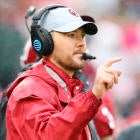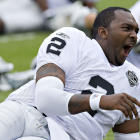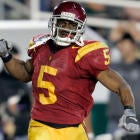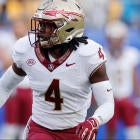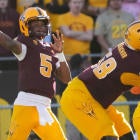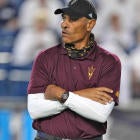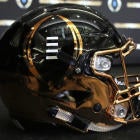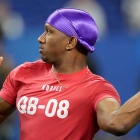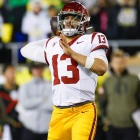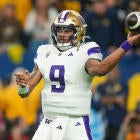It just might be the most unique head coaching hire in college football history.
That's the takeaway at Oklahoma now that the shock has subsided from Bob Stoops' resignation.
Let's put this in perspective: Sure, new coach Lincoln Riley is young. At 33, he is currently the youngest FBS coach.
Sure, Riley is taking over a football factory. Never mind Oklahoma being loaded again and favored to win an 11th conference title in the last 19 years. The Sooners are easily a top-10 all-time program.
Sure, quarterback Baker Mayfield is a returning Heisman Trophy finalist having led the nation in passer rating.
Put all those factors in a blender. Has a power this mighty ever been trusted to a leader this young becoming a first-time FBS head coach?
"What an awesome opportunity for him to step into one of the 10 best jobs in the country, completely loaded and you inherit Baker Mayfield," said FIU coach Butch Davis.
"You've got a lot of tools in the chest when you walk into that place."
There really aren't many comparisons.
- Terry Brennan was 25 when he took over at tradition-rich Notre Dame in 1954. The first season, the Irish were No. 1 in Week 2 and finished 8-1. During his Brennan's time, Paul Hornung won the Heisman and the Irish broke Oklahoma's 47-game winning streak in 1957.
- Knute Rockne was 29 when he took over in South Bend. A year after his hiring in 1918, the Irish claimed the first of what the school calls five national championships during Rockne's run.
- At age 31 in 2006, Pat Fitzgerald was the youngest FBS head coach hired since 2001. Despite Fitz's success, no one would call Northwestern a national power.
- Lane Kiffin was a first-time FBS head coach at age 33 at Tennessee in 2009. Yes, the marriage ended badly after one season. Yes, Tennessee is not quite equivalent to Oklahoma.
- At age 33, Rick Neuheisel was elevated after Colorado's Bill McCartney suddenly retired following the 1994 season. Neuheisel took over a program that was in the middle of its greatest run in school history. In 1995, the Buffs were five years removed from a national championship. They were a season removed from an 11-1 finish and No. 4 ranking. Neuheisel's first two teams finished a combined 20-4. However, CU is on no one's list of top 10 programs.
- Tom Osborne might be the best modern example. But even in 1973 when he replaced Bob Devaney, Osborne was already 36. His first Nebraska team was ranked No. 4 in the preseason. The previous four Cornhusker teams had finished 11, 1, 1 and 4 in the AP Top 25.
- Bud Wilkinson made Oklahoma into a national power after taking over at age 30 in 1947. By the time Barry Switzer replaced Chuck Fairbanks in 1973, OU was closer to the OU we know today. Switzer would go on to win three national championships (like Wilkinson), but there is one historical differentiator for the sake of this discussion: Switzer was 35 at the time -- two years and two months older than Riley.
What's Riley getting into? Like we said, it's a unique hire. Riley was a Mike Leach assistant at Texas Tech at the age of 23. At 26, he was calling plays for Ruffin McNeill at East Carolina.
But none of it would have been possible if Leach hadn't seen something special in a quarterback he "cut" at Texas Tech back in 2002. Back then, Kliff Kingsbury and B.J. Symons -- at least -- were ahead on the depth chart of the kid from Muleshoe, Texas.
"I had to get rid of two [quarterbacks] to make the roster fit," Leach said. "Lincoln was one I was going to get rid of for sure. I bring him in and I cut him. I'm thinking, 'It's going to be real easy, and it's going to be easy hiring him as a student assistant.' He wasn't real happy."
However, Riley had picked up the offense instantly as a player. That translated to a budding coaching career. A "right-hand guy," as Leach called him, Riley was "as good as anybody I ever had."
Riley was still college-aged (23) when he was elevated to receivers coach for Leach in 2007. That transformed into a steady four-year climb from student assistant to grad assistant to full-time assistant. After Leach was fired in 2009, Riley went to East Carolina where he became a coordinator for the first time at that tender age of 26.
When Bob Stoops went looking for a offensive coordinator in 2015, he wanted to get back to more Air Raid concepts. In two seasons, Mayfield has become one Oklahoma's all-time best quarterbacks. The Sooners went to the College Football Playoff in Riley's first season.
To call him a prodigy might be underplaying it.
"I just have never had a hard time remembering football plays or situations," Riley said last week on Fox Sports' "The Audible" podcast. "I have a hard time at times remembering [other things]. I have to think twice about my wife's phone number. I really struggle with birthdays.
"But if you asked me about a play we called six years in a situation, I don't know how to explain it. I've always relied on that memory."
Kiffin has some advice. He and Kingsbury (Texas Tech, 2013) were the two prior "youngest" Power Five FBS coaches hired before Riley.
"Slow down," Florida Atlantic's coach said, "and make all the decisions with the big picture of the program [in mind]. When you first get that job, he's probably going to feel this tremendous amount of pressure.
"Where's my recruiting class? What did the guy say about my draft? Who gives a shit? No one is going to care."
When he was 33, current Miami coach Mark Richt was calling plays for Florida State. His star was about to take off. In 1993, Charlie Ward won the Heisman, FSU won its first national championship. If he wasn't before, Richt was one of Bowden's top lieutenants. Could he have taken over the program at that point?
"No," Richt said. "At the moment, I wasn't ready."
When Danny Ford took over full time in 1979 at age 30, no one would call Clemson a national power. The Tigers were coming off the second double-digit win season in their history (11-1 and an ACC title in 1978).
But prior to that season Clemson was 45-60-4 record from 1968-77. Charlie Pell departed abruptly for Florida leaving Ford with much of the foundation for the 1981 national championship team.
But even that pales to what Riley has inherited at OU.
"When Bob [Stoops] called me, without hesitation I recommended him," Leach said.
"You can't always describe to someone how to be a head coach. There are can't-make-it guys who excel. There are can't-miss guys who fail … The ability to balance and not overreact is important."
Young guns
Thanks to the folks at SportsSource Analytics for compiling this list of the 10 first-time FBS head coaches since 2001 aged 30-34. Seven of the 10 improved the program's winning percentage from the previous five years. You'll notice that Lane Kiffin at Tennessee on that list best equates to Lincoln Riley taking over at Oklahoma.
* Power Five coach | ^ Improved program from previous five years
- 2001: Greg Schiano, Rutgers, 34*^
- 2006: Pat Fitzgerald, Northwestern, 31*^
- 2009: Lane Kiffin, Tennessee, 33*
- 2009: Steve Sarkisian, Washington, 34*^
- 2010: Willie Taggart, Western Kentucky, 34^
- 2012: Matt Campbell, Toledo, 32^
- 2013: Kliff Kingsbury, Texas Tech, 33*
- 2013: P.J. Fleck, Western Michigan, 33^
- 2015: Neal Brown, Troy, 34^
- 2016: Mike Norvell, Memphis, 34^
Leftover Lane
Sometimes even the internet can limit Lane Kiffin. I wrote about Florida Atlantic's new coach last week. The following quotes didn't make it into the story, well, because at some point you've got to end the story. Thought they might be interesting:
Raves for FAU president John Kelly: "I didn't know what football did for a university until a USC associate AD told me about Pete Carroll during our run. If you win, you make money. That's why it's so important to find a president. He's [Kelly] is why I'm here. This guy led the interview. It was him, the AD and three biggest money people. He talked more than any of them. He was recruiting me. He knew if he gets his program fixed, what it does for the university."
On being the CEO: "In the NFL you don't do the other stuff -- donors, boards of trustees, faculty athletic rep and provost. I didn't even know what those words were."
On going through USC's infractions committee hearing in 2010: "I was not part of the hearing at all. USC wanted me to sit through it. I look up and the chair, Paul Dee, is freakin' sleeping. He's, like, snoring." (Ironically, at that time Dee's own program at Miami was being infiltrated by Nevin Shapiro.)
On FAU's staff size compared to Alabama, which is largely thought to have the largest: "We're mini-Bama."
Pac-12 woes
Don't assume the Big 12 is going to break up when its media contract expires in 2025. That's because the Pac-12 continues to fall further behind its Power Five brethren in revenue.
You can see the recently released numbers. What's more troubling is the Pac-12 returned only 70 percent of its revenue to its 12 schools.
That's by far the smallest percentage among the Power Five. Costs of building out a new headquarters in San Francisco and maintaining a large staff get the biggest blame.
Who's to say the Big 12 at some point doesn't reach out and try to snag, say, Arizona and Arizona State? More money for them and if that's enough to keep Texas and Oklahoma, why not?












